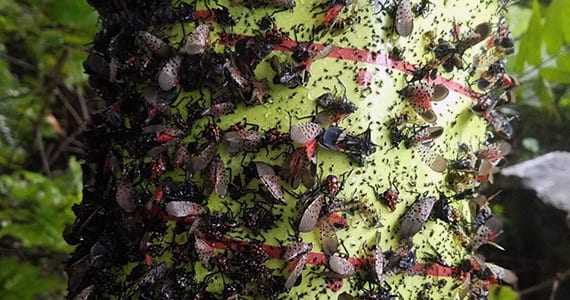We’ll turn pretty gross into pretty much gone.
What To Do About These Invasive Insects
Your privacy is our priority. None of your information will be given or sold to any person, business or entity.
Spotted Lanternfly Control Program
The Spotted Lanterfly is an invasive insect first detected in 2014 in Berks County, PA. Since then, the pests have spread to 13 counties, which are currently under quarantine. Lancaster County is included in the quarantine to prevent further infestation and damage to plant life. Our staff is here to help you if you have a Spotted Lanternfly issue on your property.
Program Details
Tomlinson Bomberger offers a Spotted Lanternfly Control program that includes a personalized recommendation tailored to each property. This program is based on the recommendations from the Penn State Extension offices, and includes an inspection of your property, removal of host Ailanthus plants, instruction on the use of sticky bands, and a program of population control treatments on target plants.
Please contact us for your free consultation today!
The Spotted Lanternfly Invasion
The spotted lanternfly is an invasive insect species native to parts of Southeast Asia. Its U.S. arrival began in 2014, and has spread to 13 counties in southeastern Pennsylvania, including Lancaster, Lebanon, and Chester. Possible egg sites include vehicles, campers, yard furniture, wood piles, farm equipment or other items you store outdoors.

Do You Have Spotted Lanternfly on Your Property?
The Spotted Lanternfly seems to require Tree of Heaven to reproduce. Other vulnerable trees include ornamental fruit trees like cherry, plum, pear, and crabapple trees, as well as maples and possibly poplar trees. If you have these trees on your property, you’re at a higher risk for a full-scale infestation.
Evidence of Spotted Lanternfly
- Black mold on bark and leaves called “black sooty mold.”
- Egg masses on flat surfaces (commonly tree trunks) covered in a gray substance similar to putty.
- Weeping sap wounds on tree trunks.
- Black or red instars (young) or adult lanternflies feeding on trees.
How To Control the Spotted Lanternfly
-
Remove Ailanthus Trees (aka “Trees-of-Heaven”)
Spotted Lanternfly requires the ailanthus altissima to reproduce. This tree is the spotted lanternfly’s primary target and must be removed.
-
Collect Egg Masses
Scrape eggs masses into a bottle or sandwich bag containing rubbing alcohol or hand sanitizer. This will kill the eggs so they do not hatch. Visit the Penn State Extension for more information.
-
Apply Sticky Bands to Trees
Wrap tree trunks in a sticky material that attracts nymphs. Once stuck, the nymphs won’t be able to feed and reach adulthood.
-
Use Pesticides
While no pesticides are currently labelled for use on the Spotted Lanternfly, a combination of systemic and contact pesticides seems to be effective.

""Your pest control technician has been providing pest control services for us for 6 years. We sincerely appreciate the services he has provided, including the fact that he is always concerned that we are satisfied with the results. He is friendly, sincere, and a credit to your company. Having been in the services business during my career, I appreciate his attitude.""
Ed R. | Lancaster
""After having a very bad mosquito problem for a few years we hired Tomlinson Bomberger take care of the problem. Our kids were getting bitten even during the daytime! We saw a huge improvement which enabled us to enjoy the outdoor space that we love.""
Michael S. | Lancaster

